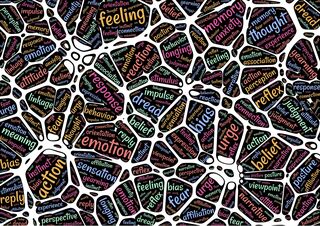Neuroscience
How Does Psychotherapy Change Our Brains?
Talk therapies lead to the reintegration of neural systems involved in stress.
Posted November 2, 2020 Reviewed by Ekua Hagan
In part 1, we saw how nature and nurture are inextricably interwoven in human brains. Whilst we all share broadly similar neural architecture, the precise details of how neural systems organize, communicate, and coordinate with each other depend on the experiences we have, particularly as children.
In a "good-enough" childhood, our caregivers and others are (at least largely) sources of calm, nurture, and reassurance, which gives us safety to develop and explore and to learn how to manage stress, fear, and other emotions. This allows optimum neural development, and a healthy, flexible interplay between the more primitive, emotional limbic system, and the more abstract, cognitive cortical parts.
However, experiencing chronic stress in childhood, or a lack of help in making sense of emotions or regulating emotion, can interfere with normal neural development. High levels of stress hormones can interfere with memory and thinking and lead to the dysregulation of systems that manage stress. As adults, traumatic events can lead to dissociation and interfere with interactions between neural systems too.
Louis Cozolino argues that it is always the "inadequate growth and integration within and between networks" that leads patients to seek psychotherapy. Research demonstrates that successful psychotherapy is indeed correlated with changes in brain activity and connectivity.

But how could "just talking" rewire a brain?
1. Firstly, psychotherapy is a special type of enriched learning environment — particularly for social learning. All learning is reflected in "neural plasticity," that is, in the excitability, growth, connection, and reorganisation of connections between neurons. Appropriate psychological stimulation and challenge encourages new growth and improved connectivity of neurons and a better blood supply to neurons.
2. A good therapist encourages change by keeping stress and psychological arousal at mild to moderate levels, which is known to activate growth hormones and best support learning at the neural level.
Stress and arousal are both double-edged swords. When very low, we are not motivated to learn or change. But too much, and we are flooded by responses by our primitive limbic system — which turns off our ability to think well; or, at the extreme leads to dissociation.
3. A supportive therapist initially acts like a good parent, soothing and modeling how to re-regulate strong emotions. Repeated cycles of dis-regulation and re-regulation allow a client to build and integrate the relevant neural circuits that allow affect internal regulation. In accord with this, neuro-biological research shows that therapy increases inhibitory feedback from the prefrontal cortex, which down-regulates the emotional limbic system.
Once we can regulate our sub-cortical, subconscious emotional responses and impulses, our conscious, verbal cortex can remain engaged even in the face of strong emotions. In effect, we learn how to create a safe internal environment to deal more thoughtfully with the things that have perhaps always felt overwhelming or to be avoided, whether that is past memories and learning, or day to day events.

4. Therapy encourages the integration of feelings and thoughts, and better communication between these neural systems. Under stress, our capacity for thought and language are reduced. This means that our most meaningful experiences can be the most difficult to process, and often escape rational consideration.
Only our "neomammalian" cortex is capable of consciousness and verbal communication, whereas the limbic system (emotion, learning, and memory) influences our actions unconsciously. In therapy, integration between these systems is encouraged by deliberate language (verbal, writing, symbol making) in the context of more primitive feelings.
New narratives can be constructed as we become aware of the real relationship between feelings and thoughts, which allows a change in world view, and better decision-making.
5. Bruce Ecker argues that the complete erasure of neural traces of unhelpful schemas and beliefs underpins transformational change.
Until recently, it was assumed that old memories are never deleted — but remain alongside any new learning. However, we now know that when we reactivate any memory we make it "labile" — that is, open to interference for a period of time.
If therapy brings a specific memory (with its associated faulty interpretations) to consciousness, whilst simultaneously encouraging the voicing of contradicting information that we now know as adults, the conflict leads to the loss of traces of earlier beliefs and interpretations. The trace for the original event itself remains (it is not in conflict), but any erroneous conclusions that do not bear current witness can be removed.
Psychotherapy now has a strong neurobiological rationale. Good psychotherapy produces physical changes in the brain that allow for better functioning, integration, and regulation of neural systems, that underpin improved mental health, especially when we are under stress. In particular, changes in the frontal and temporal cortex that mediate the regulation of emotion, thinking, and memory seem most important.
A supportive therapeutic relationship is a particularly powerful way to address the re-regulation of emotion, faulty social learning, and learnt psychological defences. However, it is the conscious, verbal cortex that provides the rationalizations that often keep our self-destructive coping mechanisms in place for a lifetime. In the last part of this series, I will outline some "self-help" techniques that we can use to help shift our thinking and get us unstuck. Look out for it on 23 November.
References
Cozolino, L. (2017) The Neuroscience of Psychotherapy: Healing the social brain. 3rd Edition. New York, U.S.A.: W.H. Norton & Company.




